My interest in awamori began from a place of skepticism. We’ve all read the spiel about some local liquor somewhere, which often falls into the “nice to try on holiday, wouldn’t care for again” category. This is how I started out before I tripped and fell down the rabbit hole into the world of Japan’s oldest distilled liquor.
Awamori has flavor profiles as deep as its 600 years of history. Official tasting note suggestions for this fascinating Okinawan liquor, range from “fruity,” “nutty,” and “vanilla,” to wilder options like “yogurt” and “mushroom.” My personal favorites are aged awamori with seductive notes of burnt caramel. What’s more, often at around 30 – 40% alcohol content, it can easily be used as a base for cocktails as well as drunk straight.
Here’s a guide on what awamori is all about it, and why you might just end up hooked (like me).
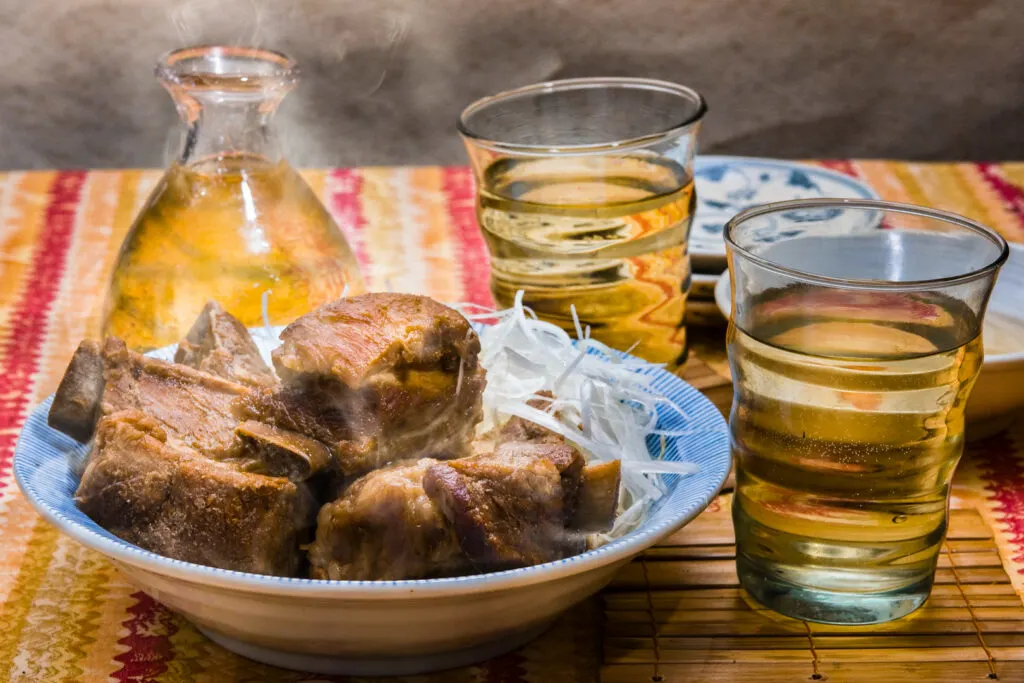
Table of Contents
What is awamori?
Awamori is a liquor made from rice, with water and black koji mold (kuro kōji), which is then fermented and distilled to produce a spirit that must be less than 45% alcohol content. It is then matured to develop the flavor over time.
The distillation technology is believed to have arrived in Okinawa — then known as the Ryūkyū Islands — in the 15th century from Siam (modern-day Thailand). The term “awamori” itself then appeared for the first time in 1671 in a catalog of items that were delivered to a general of the Edo shogunate, showing also that it was a beverage worthy of gift-giving.
Production expanded over the centuries, although it took a serious hit during WWII, which left many distilleries damaged and led to the loss of many aged awamori varieties, some over 100 years old.
Another challenge came with the reunification of Okinawa with mainland Japan in 1970, which increased competition with sake and Western liquors. Awamori needed to drastically change its image as it was seen as a strong-smelling beverage that was drunk at home. In response, great efforts were made to improve the production process and taste through closely collaborating with producers.
Nowadays, awamori is considered the quintessential Okinawan drink, but it still remains relatively unknown outside the region. Producers are striving to show it’s a beverage that can — and in my sober opinion should — be enjoyed globally.
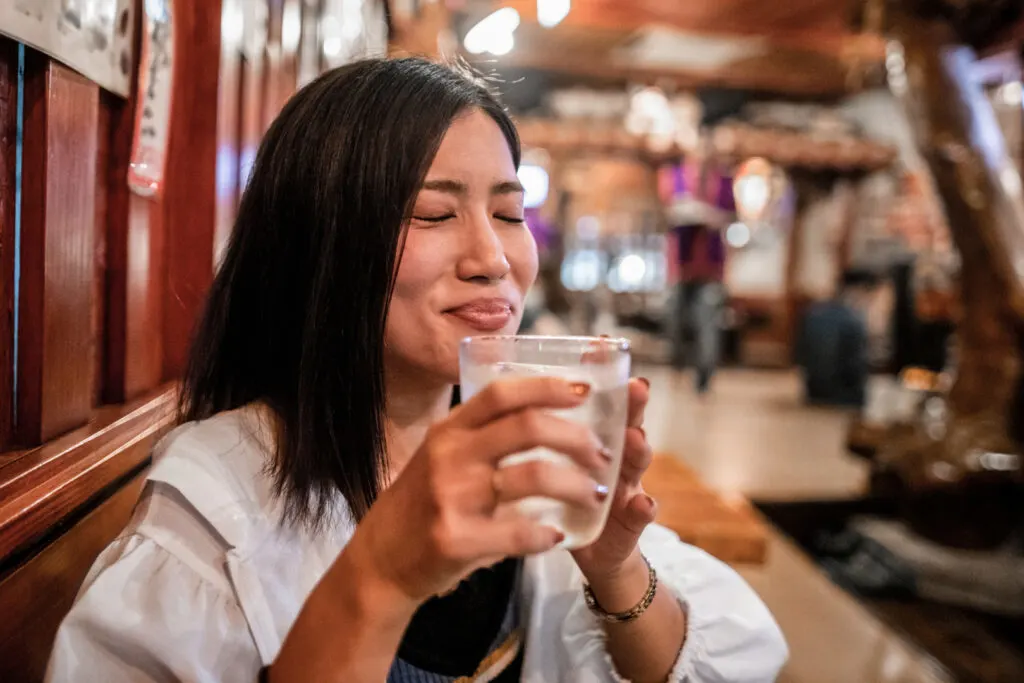
How is awamori made?
Throw away romantic images of terroir — at least, partially. The vast majority of rice in awamori production is indica rice that’s imported from Thailand, as it’s far more suited to the production process than native japonica rice.
Specifically, the hardness of the rice makes it easier to work with when making koji, and producers can more easily control the temperature when adding water or yeast during the alcoholic fermentation. It also results in awamori with a higher alcohol yield.
Terroir, however, appears in the form of the other essential ingredient — black koji. This is a mold indigenous to Okinawa, and it’s absolutely essential for fermentation to occur.
Compared to white koji which tends to be used for shochu production or yellow for sake, black koji produces a large amount of citric acid, which helps to inhibit the growth of bacteria — something which is really helpful for safely fermenting rice in Okinawa’s hot and humid climate.
To kick off the process, the rice is washed and steamed. Then, black koji spores are sprinkled in to inoculate the rice over the next two days, with the producers closely controlling the temperature.
Next, the rice is transferred into a large tank, and water and yeast is added. This mix is known as the moromi, and it will undergo a transformation over the next two weeks or so. Enzymes in the koji work to break down the rice into sugars, a process known as saccharification, and the yeast will then feast upon the sugars to produce alcohol. Distillers will carefully monitor the fermentation and control the temperature by using cold water jackets or immersible coils to prevent overheating.
After about two weeks, the moromi is distilled in a pot still. This process is only carried out once, which means the resultant liquor still retains a lot of other components, and that contributes to awamori’s rich flavor. But there’s no diving into the drink just yet – the alcohol content is far too high, and water must be added to adjust it to the appropriate level of below 45%.
The awamori will then be left to mature in tanks or earthenware pots before being bottled and sold — but the flavor will also continue to develop over time.
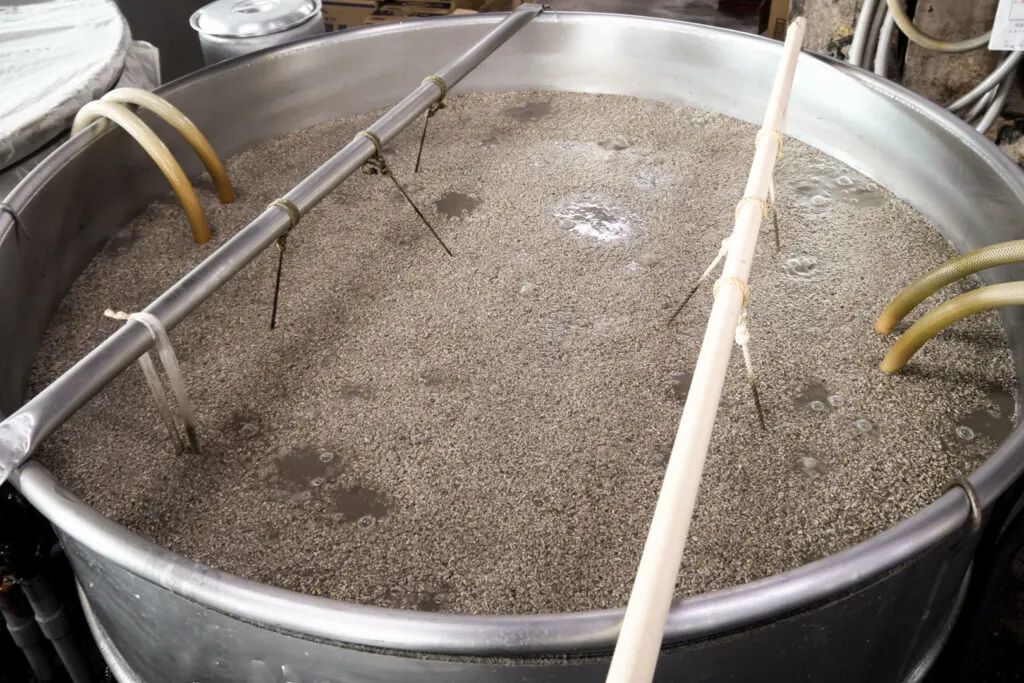
Why is it called awamori?
There’s some debate over the origin of the term awamori (泡盛, あわもり), literally “bubbles piled up,” including a miswriting of the kanji for millet (粟, also pronounced “awa” like bubbles), and a Sanskrit word “awamuri” for alcohol.
Perhaps the most popular explanation which best fits the modern-day kanji is the “foam theory.” A method in olden times to check the quality of distilled liquor was to pour it slowly from a cup into a bowl at a slight height and see how foamy the liquid becomes, with the finer the bubbles and the longer it took for them to disappear supposedly indicating higher quality.
Types of awamori
While “awamori” itself is legally defined, there are some interesting variations out there. Here are some types you’re likely to come across.
Kusu
Kusu is an Okinawan term for koshu (古酒, aged sake) and only applies to awamori that has been aged over three years or more. This is said to bring out a mellower, more rounded flavor.
While tank ageing constitutes the bulk of production, many still use kame (earthenware pots). This requires a lot of care — any improperly sealed pot will lead to an awamori with 44%, for example, tragically dropping to just 20% over time, becoming a watery shadow of its former self.
In fact, Chūkō Distillery in Tomigusuku City takes things to the next level by firing their own to ensure that no alcohol escapes through microscopic cracks.
Hanazake
On Yonaguni, Japan’s westernmost island, local people clearly know how to party. It’s the only location where awamori produced can exceed the 45% limit due to its traditional use in religious ceremonies.
Hanazake (花酒), literally “flower liquor,” has an alcohol content of 60%, and is traditionally drunk straight.
Habushu
Visually striking or absolutely terrifying depending on your perspective, habushu (ハブ酒) features a habu, a notoriously venomous Okinawan snake, coiled inside a jar of booze.
While some claim the liquor has a mellow, sweet taste, others describe the flavor as “complex” — make of that what you will! It’s also said to have several health benefits, particularly for gentlemen.
Note that it’s not such a great end for the snake, however. Traditionally, the habu is kept alive in a pot for several months and starved to clean out its digestive system, before having alcohol poured on it while it’s still alive. Some newer methods now involve killing the snake and stripping out the internal organs.
While habu venom is deadly, habushu is completely safe to drink, but opting for an official brand rather than anything homemade is the best way to ensure quality.
Technically, the alcohol used isn’t always awamori, but it’s the most common; a high alcohol content is necessary to prevent the snake from rotting. Some versions also add herbs, brown sugar and other ingredients.
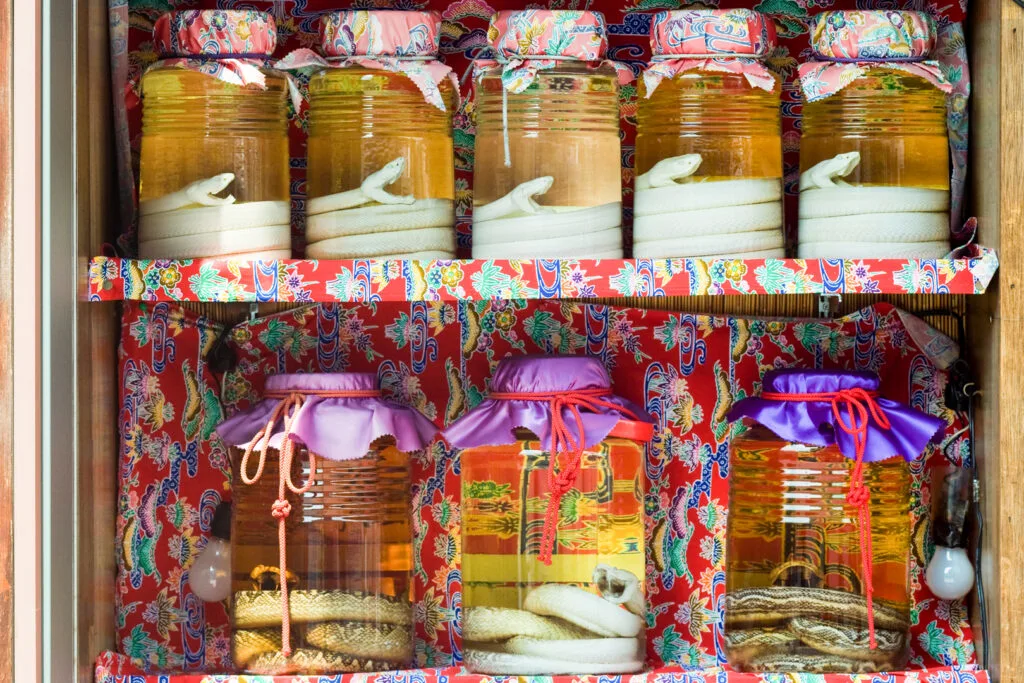
How to drink awamori
Awamori proves itself to be a very versatile friend and a true people-pleaser; there are many different ways to enjoy the beverage.
The most traditional style is to drink awamori straight from tiny, almost thimble-sized drinking cups known as chibuguwa. Note that it’s meant to be sipped slowly, not downed in one shot. Take your time to appreciate the aroma before you sip, and then again once you’ve finished your cup.
Kusu (aged awamori) often has a vanilla or caramel scent, and drinking it from a champagne glass can help to enhance the experience.
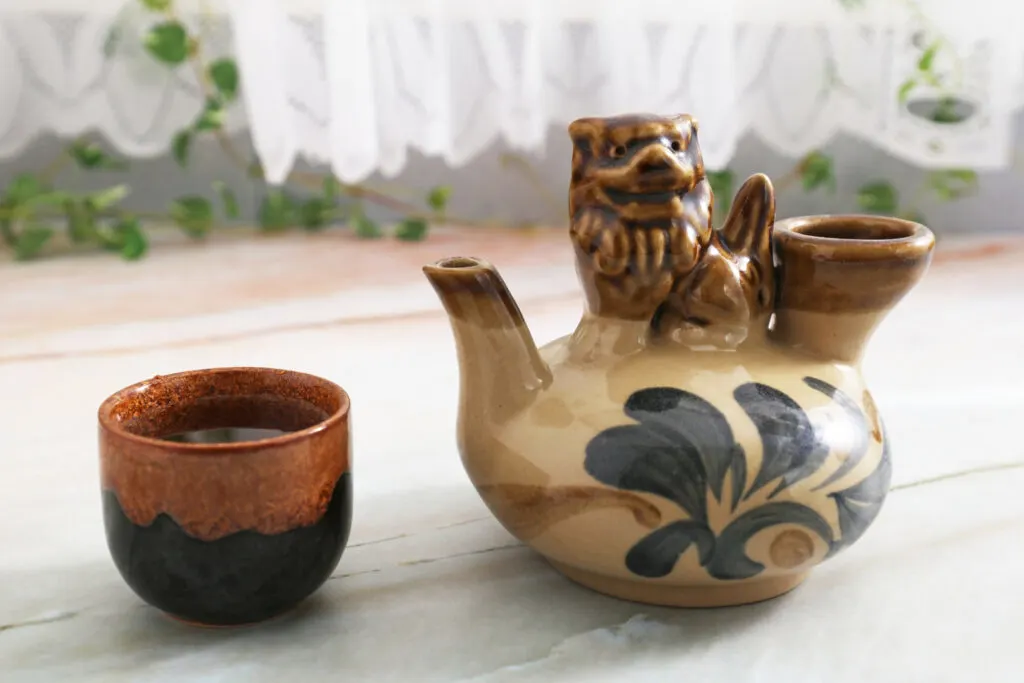
Awamori can also be cut with cold or hot water: soft water with ice will make the taste smoother, whereas hot water allows the mellowness of the fat to spread out, giving a softer, more rounded drink.
At 30 – 40% alcohol content, it is also a great cocktail base and pairs particularly well with citrus flavors. I highly recommend you try it with shikuwasa (シークヮーサー), a local Okinawan citrus fruit.
For the ultimate deep dive into Okinawan culture, start the day with an extra kick from awamori coffee, which is sold in local convenience stores but can also be easily made at home.
Where to drink awamori
Awamori is without fail on the menu at any Okinawan restaurant, and it’s widely available to buy at supermarkets and other stores.
For a great choice in Naha, stop by Karakara to Chibuguwa, which is run by an Awamori Meister (an Okinawan government certified expert!) The entire bar is lined with bottles, and you can sample various awamori, from relatively young awamori matured only two to three years, to some that are more than 30 years old, all served from traditional drinking vessels.
If you find yourself a little north of Naha, a visit to Awamori Pub Yomitan Monogatari is a must. Yomitan is home to one of Okinawa’s most famous awamori brands, Zanpa, and this izakaya has an extensive line-up, alongside some original and highly creative cocktails. (As an aside, I also highly recommend ordering the squid ink soba — delicious!)
Awamori today
The awamori industry faces a problem plaguing many across Japan — a steeply declining population is leading to a lack of human resources, but also a shrinking domestic market. There are currently 47 licensed distilleries in Okinawa, but one is currently not producing and the future of another remains uncertain.
This trend is seeing distillers increasingly push towards innovation and the overseas market. One example is Blueship Okinawa, a company established in 2016 that is collaborating with three leading distilleries to produce the brand RYUKYU 1429.
Since 2019, they’ve been distributing to several countries in Europe and are focusing on cocktails, alongside getting renowned bartenders on board, who could help to raise awamori awareness through becoming awamori influencers.
Grab yourself some awamori and watch this space for further creativity. As they say in Okinawa when it’s time for a toast: kari!
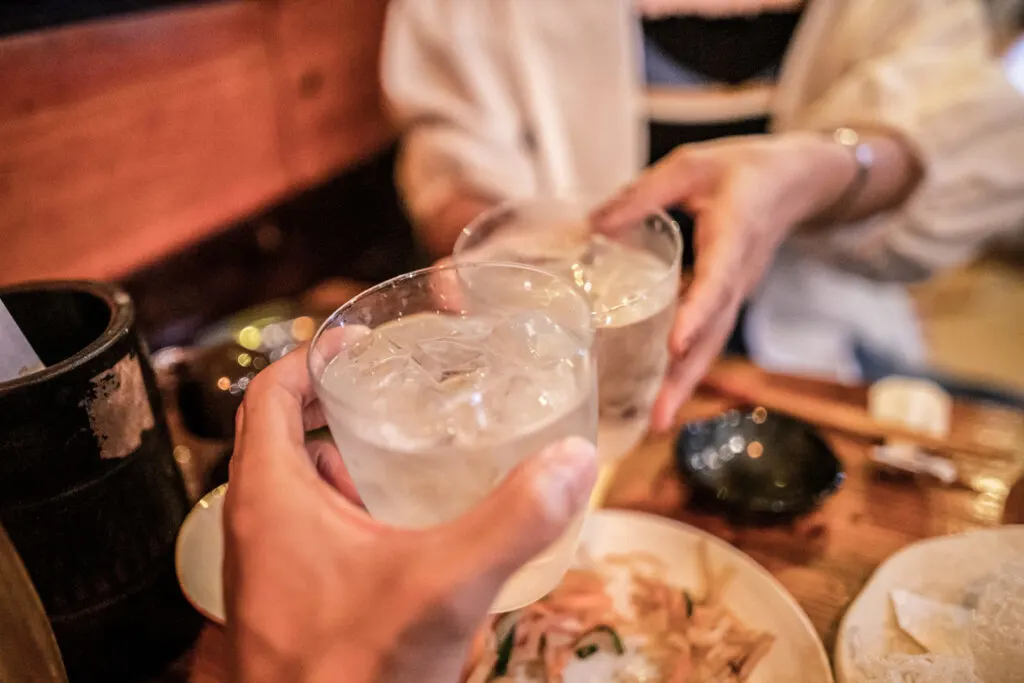
Pin me for later
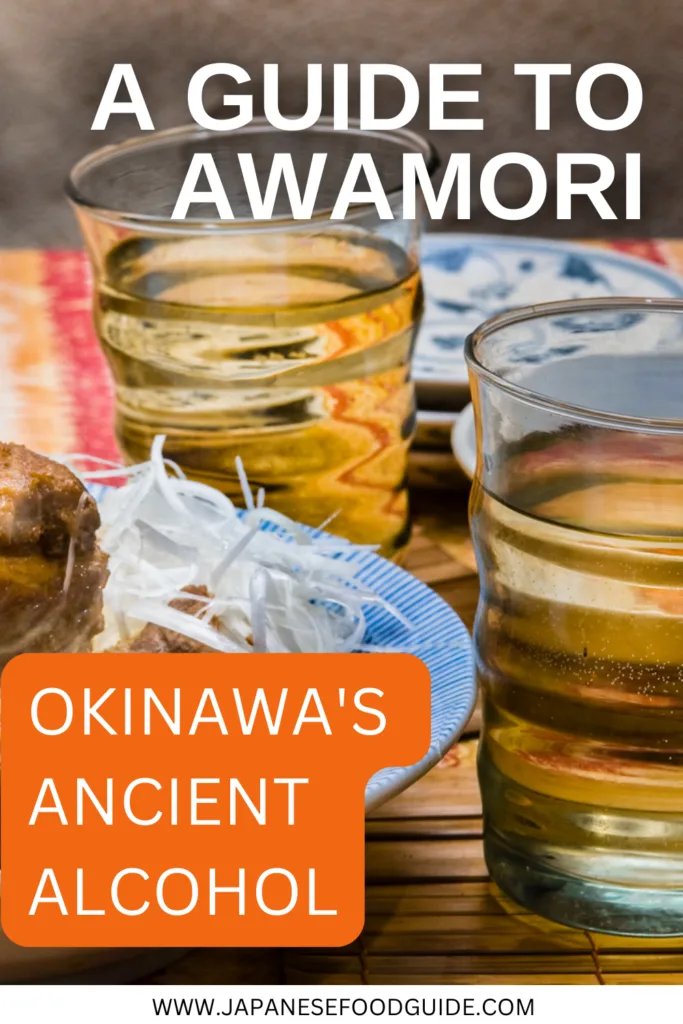
Phoebe Amoroso is a Tokyo-based reporter, multimedia journalist and storyteller. Hailing from the UK, she moved to Japan in 2014 and has since been shouting about the country to all who will listen.
She divides her time between covering breaking news and producing feature stories for TV; writing about everything from business and tech to food and travel; and guiding hungry visitors who want to sample the best of Japanese cuisine. When not working and/or eating, she can often be found running up a mountain or cycling by the sea.
